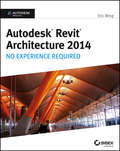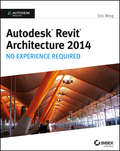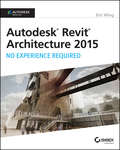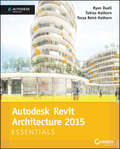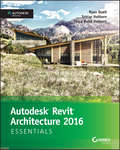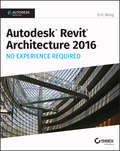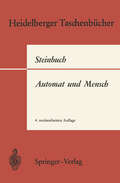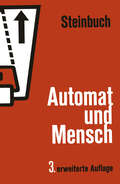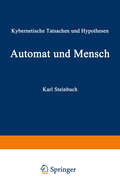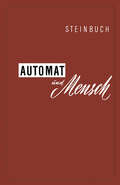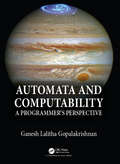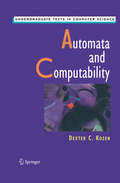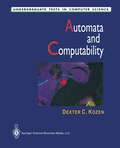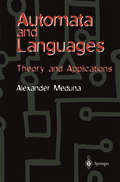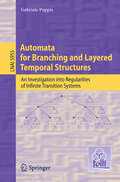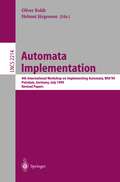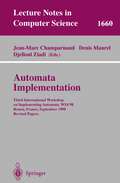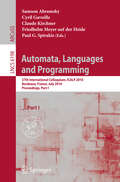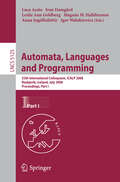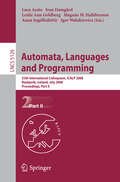- Table View
- List View
Autodesk Revit Architecture 2014: No Experience Required Autodesk Official Press
by Eric WingLearn Revit Architecture with an engaging, real-world continuous step-by-step tutorial This Autodesk Official Press book helps you become proficient with Autodesk's popular building information modeling software using an innovative continuous tutorial. It covers each phase of designing, documenting, and presenting a four-story office building, a real-world project you might expect to encounter on the job. Concise explanations, focused examples, step-by-step instructions, and an engaging hands-on tutorial make this Autodesk Official Press guide the perfect way to learn Revit Architecture. Expert author Eric Wing, first introduces the interface and Revit conventions and then moves directly into building modeling. You'll learn to place walls, doors, and windows, work with structural grids, beams, and foundations; add text and dimensions, and use dimensions as a design tool. As the building takes shape, you'll discover how to generate construction documentation, create schedules, consider site issues, and use Revit's rendering capabilities. Shows you how to work on a real-world design from start to finish Helps you to understand industry best practices and quickly become proficient with the user interface Explains how to effectively plan and create walls, doors, window, floors, and ceilings Details ways to create professional stairs and railings Walks you through using Revit's powerful dimensions, families, worksets, worksharing, and phase management features vEncourages you to show off your design with beautifully lit, fully rendered 3D scenes Autodesk Revit Architecture: No Experience Required features downloadable tutorial files so you can jump in at any exercise. It's the perfect resource for learning this essential BIM software.
Autodesk Revit Architecture 2014: No Experience Required Autodesk Official Press
by Eric WingLearn Revit Architecture with an engaging, real-world continuous step-by-step tutorial This Autodesk Official Press book helps you become proficient with Autodesk's popular building information modeling software using an innovative continuous tutorial. It covers each phase of designing, documenting, and presenting a four-story office building, a real-world project you might expect to encounter on the job. Concise explanations, focused examples, step-by-step instructions, and an engaging hands-on tutorial make this Autodesk Official Press guide the perfect way to learn Revit Architecture. Expert author Eric Wing, first introduces the interface and Revit conventions and then moves directly into building modeling. You'll learn to place walls, doors, and windows, work with structural grids, beams, and foundations; add text and dimensions, and use dimensions as a design tool. As the building takes shape, you'll discover how to generate construction documentation, create schedules, consider site issues, and use Revit's rendering capabilities. Shows you how to work on a real-world design from start to finish Helps you to understand industry best practices and quickly become proficient with the user interface Explains how to effectively plan and create walls, doors, window, floors, and ceilings Details ways to create professional stairs and railings Walks you through using Revit's powerful dimensions, families, worksets, worksharing, and phase management features vEncourages you to show off your design with beautifully lit, fully rendered 3D scenes Autodesk Revit Architecture: No Experience Required features downloadable tutorial files so you can jump in at any exercise. It's the perfect resource for learning this essential BIM software.
Autodesk Revit Architecture 2015: Autodesk Official Press
by Eric WingLearn Revit Architecture the hands-on way For those who like to learn by doing, this Autodesk Official Press book shows you how to build a four-story office building one step at a time, providing you with real-world practice you might expect to encounter on the job. Concise explanations, focused examples, step-by-step instructions, and an engaging hands-on tutorial make this book the perfect way to learn Revit Architecture. In addition, you can download starting files for each chapter from the website in order to compare your work to the authors, or start fresh with any chapter in the book. Expert author Eric Wing first introduces the interface and Revit conventions, and then moves directly into building modeling. You'll learn to place walls, doors, and windows, work with structural grids, beams, and foundations; add text and dimensions, and use dimensions as a design tool. As the building takes shape, you'll discover how to generate construction documentation, create schedules, work with families, consider site issues, and use Revit's rendering capabilities. Here are some of the skills you can acquire from this book: Understanding Revit's interface, views, and grids Creating and editing roofs, railings, stairs, and ceilings Generating documentation and construction schedules Using advanced features like creating hosted families, system families, and formulas Autodesk Revit Architecture: No Experience Required is a completely self-paced guide. You can work along with the tutorial from cover to cover or jump in anywhere. No matter how you use this book, you'll be able to transfer the useful concepts to your professional practice.
Autodesk Revit Architecture 2015: Autodesk Official Press
by Eric WingLearn Revit Architecture the hands-on way For those who like to learn by doing, this Autodesk Official Press book shows you how to build a four-story office building one step at a time, providing you with real-world practice you might expect to encounter on the job. Concise explanations, focused examples, step-by-step instructions, and an engaging hands-on tutorial make this book the perfect way to learn Revit Architecture. In addition, you can download starting files for each chapter from the website in order to compare your work to the authors, or start fresh with any chapter in the book. Expert author Eric Wing first introduces the interface and Revit conventions, and then moves directly into building modeling. You'll learn to place walls, doors, and windows, work with structural grids, beams, and foundations; add text and dimensions, and use dimensions as a design tool. As the building takes shape, you'll discover how to generate construction documentation, create schedules, work with families, consider site issues, and use Revit's rendering capabilities. Here are some of the skills you can acquire from this book: Understanding Revit's interface, views, and grids Creating and editing roofs, railings, stairs, and ceilings Generating documentation and construction schedules Using advanced features like creating hosted families, system families, and formulas Autodesk Revit Architecture: No Experience Required is a completely self-paced guide. You can work along with the tutorial from cover to cover or jump in anywhere. No matter how you use this book, you'll be able to transfer the useful concepts to your professional practice.
Autodesk Revit Architecture 2015 Essentials: Autodesk Official Press
by Ryan Duell Tobias Hathorn Tessa Reist HathornYour step-by-step guide to learning Autodesk Revit Architecture This detailed introduction to Revit Architecture features straightforward explanations and real-world, hands-on tutorials to teach new users the software's core features and functions. Presented in the context of real-world workflows, and using real-world projects, each chapter contains a discussion of the "why" and "how" that is reinforced with a step-by-step tutorial so you'll gain practical and applicable experience with the core features of Revit Architecture. The new pedagogical approach emphasizes learning skills to help you prepare for the Revit certification exams. Learn at your pace with step-by-step exercises, illustrated with full-color screenshots and downloadable Revit tutorial files Work with floors, ceilings, walls, and curtain walls Use modeling and massing to explore design ideas Use the Family Editor to create and manage families Understand effective worksharing, BIM workflows, and file management Use rendering and visualization techniques to make your design come alive Prepare for Revit certification exams With Autodesk Revit Architecture Essentials, you are only a step away from better, faster building design.
Autodesk Revit Architecture 2015 Essentials: Autodesk Official Press
by Ryan Duell Tobias Hathorn Tessa Reist HathornYour step-by-step guide to learning Autodesk Revit Architecture This detailed introduction to Revit Architecture features straightforward explanations and real-world, hands-on tutorials to teach new users the software's core features and functions. Presented in the context of real-world workflows, and using real-world projects, each chapter contains a discussion of the "why" and "how" that is reinforced with a step-by-step tutorial so you'll gain practical and applicable experience with the core features of Revit Architecture. The new pedagogical approach emphasizes learning skills to help you prepare for the Revit certification exams. Learn at your pace with step-by-step exercises, illustrated with full-color screenshots and downloadable Revit tutorial files Work with floors, ceilings, walls, and curtain walls Use modeling and massing to explore design ideas Use the Family Editor to create and manage families Understand effective worksharing, BIM workflows, and file management Use rendering and visualization techniques to make your design come alive Prepare for Revit certification exams With Autodesk Revit Architecture Essentials, you are only a step away from better, faster building design.
Autodesk Revit Architecture 2016 Essentials: Autodesk Official Press
by Ryan Duell Tobias Hathorn Tessa Reist HathornPut Autodesk Revit Architecture 2016 to work for you with this real-world focused guide Autodesk Revit Architecture 2016 Essentials helps you get acquainted and quickly become productive with the leading Building Information Modeling software. With a real-world focus and a tutorial-based approach, this invaluable guide features concise, straightforward explanations and hands-on exercises that walk you through the entire design process. Each chapter opens with a quick discussion of concepts and learning goals, and then briskly moves into step-by-step instruction illustrated by compelling full-color screen shots. This new edition includes expanded information on rendering and visualization, and a new discussion surrounding effective work sharing, details and annotations, drawing sets, and professional workflows. The companion website features additional tutorials, plus downloadable data sets that allow you to jump in at any point and compare your work to the pros. Revit Architecture 2016 is a powerful, sophisticated BIM application designed to boost productivity with automated documentation for every design and update. This guide takes you through the entire design process, and shows you how to get the most out of Revit every step of the way. Design walls, floors, roofs, ceilings, stairs, ramps, railings, and more Work with families, groups, and phasing, and add color fills and rendering Create compelling drawing sets with details and annotations Learn the tips and tricks experts use to get the most out of Revit Autodesk Revit Architecture 2016 Essentials gets you up to speed quickly, so you can win more bids and expedite the project approval process.
Autodesk Revit Architecture 2016 Essentials: Autodesk Official Press
by Ryan Duell Tobias Hathorn Tessa Reist HathornPut Autodesk Revit Architecture 2016 to work for you with this real-world focused guide Autodesk Revit Architecture 2016 Essentials helps you get acquainted and quickly become productive with the leading Building Information Modeling software. With a real-world focus and a tutorial-based approach, this invaluable guide features concise, straightforward explanations and hands-on exercises that walk you through the entire design process. Each chapter opens with a quick discussion of concepts and learning goals, and then briskly moves into step-by-step instruction illustrated by compelling full-color screen shots. This new edition includes expanded information on rendering and visualization, and a new discussion surrounding effective work sharing, details and annotations, drawing sets, and professional workflows. The companion website features additional tutorials, plus downloadable data sets that allow you to jump in at any point and compare your work to the pros. Revit Architecture 2016 is a powerful, sophisticated BIM application designed to boost productivity with automated documentation for every design and update. This guide takes you through the entire design process, and shows you how to get the most out of Revit every step of the way. Design walls, floors, roofs, ceilings, stairs, ramps, railings, and more Work with families, groups, and phasing, and add color fills and rendering Create compelling drawing sets with details and annotations Learn the tips and tricks experts use to get the most out of Revit Autodesk Revit Architecture 2016 Essentials gets you up to speed quickly, so you can win more bids and expedite the project approval process.
Autodesk Revit Architecture 2016 No Experience Required: Autodesk Official Press
by Eric WingGo from beginner to guru quickly with the ultimate Revit Architecture 2016 guide Autodesk Revit Architecture 2016 No Experience Required is your ultimate hands-on guide for mastering this essential BIM software. With step-by-step instruction and a continuous tutorial approach, this invaluable guide walks you through the design of a four-story office building. You'll be led through the entire design, documentation, and presentation process with expert instruction and helpful tips, so you can quickly become confident and productive. You'll follow a real-world workflow as you jump right into modeling, first placing doors and windows, then building floors layer-by-layer, adding roofs and ceilings, stairs, ramps, and railings. Coverage includes crucial information on detailing, view and match line information, and printing, plus advanced topics like curtain walls, sweeps, embedded families, and formulas. You'll delve into site considerations including grading and topsurface features, and integrate them into your design at the rendering stage. The companion website provides downloadable tutorial files so you can jump in at any point and compare your work to the pros. Revit is the industry-leading Building Information Management software, hailed for its power and sophistication. This guide helps you get the most out of the software, with expert instruction and plenty of practice. Master the interface, tools, views, and editing capabilities Work with structural objects, text, dimensions, and multi-story buildings Generate construction documentation, schedules, and material takeoffs Explore phase management, work sharing, and working with various formats BIM is the emerging paradigm for architects and others in the construction and engineering fields. Revit is the industry leader, and is quickly becoming a mandatory skillset. Autodesk Revit Architecture 2016 No Experience Required provides everything you need to get up to speed and down to work.
Autodesk Revit Architecture 2016 No Experience Required: Autodesk Official Press
by Eric WingGo from beginner to guru quickly with the ultimate Revit Architecture 2016 guide Autodesk Revit Architecture 2016 No Experience Required is your ultimate hands-on guide for mastering this essential BIM software. With step-by-step instruction and a continuous tutorial approach, this invaluable guide walks you through the design of a four-story office building. You'll be led through the entire design, documentation, and presentation process with expert instruction and helpful tips, so you can quickly become confident and productive. You'll follow a real-world workflow as you jump right into modeling, first placing doors and windows, then building floors layer-by-layer, adding roofs and ceilings, stairs, ramps, and railings. Coverage includes crucial information on detailing, view and match line information, and printing, plus advanced topics like curtain walls, sweeps, embedded families, and formulas. You'll delve into site considerations including grading and topsurface features, and integrate them into your design at the rendering stage. The companion website provides downloadable tutorial files so you can jump in at any point and compare your work to the pros. Revit is the industry-leading Building Information Management software, hailed for its power and sophistication. This guide helps you get the most out of the software, with expert instruction and plenty of practice. Master the interface, tools, views, and editing capabilities Work with structural objects, text, dimensions, and multi-story buildings Generate construction documentation, schedules, and material takeoffs Explore phase management, work sharing, and working with various formats BIM is the emerging paradigm for architects and others in the construction and engineering fields. Revit is the industry leader, and is quickly becoming a mandatory skillset. Autodesk Revit Architecture 2016 No Experience Required provides everything you need to get up to speed and down to work.
Automat und Mensch: Auf dem Weg zu einer kybernetischen Anthropologie (Heidelberger Taschenbücher #81)
by K. SteinbuchAutomat und Mensch: Über menschliche und maschinelle Intelligenz
by Karl SteinbuchDie Fähigkeiten moderner Automaten sprengen die Grenze dessen, was einst für "mechanische" Gebilde als möglich erachtet wurde. Ihre Eigenschaften werden beschrieben in Kategorien, die bisher den Menschen vorbehalten waren, z. B. logische Verknüpfung, Zei chenerkennung, Gedächtnis, Lernen. Der Mensch ist für uns das "unbekannte Wesen" [20. 7]. Unsere Einsicht in die Funktion unseres Denksystems ist gering. Wenn nun plötzlich durch Automaten vergleichbare Eigenschaften erzeugt werden können ("künstliche Intelligenz"), erschließt sich dem for schenden Geist ein neuer Weg zum Verständnis des Menschen: Nämlich über das Verständnis der Automaten. Viele überkommene Vorstellungen müssen revidiert werden. Die Frage ist: Kann man geistige Vorgänge durch Erkenntnisse an Automaten nicht verstehen, teilweise verstehen, ganz verstehen? Die häufig gegebene Antwort, daß die Erkenntnisse der Physik für den einen Teil geistiger Vorgänge zuständig seien, für den anderen je doch nicht, ist meines Erachtens ein schlechter Kompromiß. Man muß zwar zugestehen, daß unsere heutigen Erkenntnisse nicht aus reichen, um alles oder auch nur den überwiegenden Teil zu erklären, man sollte aber keinesfalls die Vermutung akzeptieren, geistige Vorgänge unterhalb einer kritischen Organisationshöhe könne man physikalisch erklären, oberhalb dieser kritischen Organisationshöhe sei jedoch eine "überphysik" zuständig. Solche Sprünge macht die Natur nicht. In diesem Buch werden die Grundbegriffe, die zum Ver ständnis moderner Automaten erforderlich sind, erklärt. In den ersten Kapiteln herrschen deshalb technische Erläuterungen vor. Hierbei ist eine leichtverständliche Darstellung angestrebt. Mathematische Formeln wurden weitgehend vermieden, dagegen sollen Bilder das Wesentliche veranschaulichen.
Automata and Computability: A Programmer's Perspective
by Ganesh GopalakrishnanAutomata and Computability is a class-tested textbook which provides a comprehensive and accessible introduction to the theory of automata and computation. The author uses illustrations, engaging examples, and historical remarks to make the material interesting and relevant for students. It incorporates modern/handy ideas, such as derivative-based parsing and a Lambda reducer showing the universality of Lambda calculus. The book also shows how to sculpt automata by making the regular language conversion pipeline available through a simple command interface. A Jupyter notebook will accompany the book to feature code, YouTube videos, and other supplements to assist instructors and studentsFeatures Uses illustrations, engaging examples, and historical remarks to make the material accessible Incorporates modern/handy ideas, such as derivative-based parsing and a Lambda reducer showing the universality of Lambda calculus Shows how to "sculpt" automata by making the regular language conversion pipeline available through simple command interface Uses a mini functional programming (FP) notation consisting of lambdas, maps, filters, and set comprehension (supported in Python) to convey math through PL constructs that are succinct and resemble math Provides all concepts are encoded in a compact Functional Programming code that will tesselate with Latex markup and Jupyter widgets in a document that will accompany the books. Students can run code effortlessly href="https://github.com/ganeshutah/Jove.git/"here.
Automata and Computability: A Programmer's Perspective
by Ganesh GopalakrishnanAutomata and Computability is a class-tested textbook which provides a comprehensive and accessible introduction to the theory of automata and computation. The author uses illustrations, engaging examples, and historical remarks to make the material interesting and relevant for students. It incorporates modern/handy ideas, such as derivative-based parsing and a Lambda reducer showing the universality of Lambda calculus. The book also shows how to sculpt automata by making the regular language conversion pipeline available through a simple command interface. A Jupyter notebook will accompany the book to feature code, YouTube videos, and other supplements to assist instructors and studentsFeatures Uses illustrations, engaging examples, and historical remarks to make the material accessible Incorporates modern/handy ideas, such as derivative-based parsing and a Lambda reducer showing the universality of Lambda calculus Shows how to "sculpt" automata by making the regular language conversion pipeline available through simple command interface Uses a mini functional programming (FP) notation consisting of lambdas, maps, filters, and set comprehension (supported in Python) to convey math through PL constructs that are succinct and resemble math Provides all concepts are encoded in a compact Functional Programming code that will tesselate with Latex markup and Jupyter widgets in a document that will accompany the books. Students can run code effortlessly href="https://github.com/ganeshutah/Jove.git/"here.
Automata and Computability (Undergraduate Texts in Computer Science)
by Dexter C. KozenThis textbook provides undergraduate students with an introduction to the basic theoretical models of computability, and develops some of the model's rich and varied structure. The first part of the book is devoted to finite automata and their properties. Pushdown automata provide a broader class of models and enable the analysis of context-free languages. In the remaining chapters, Turing machines are introduced and the book culminates in analyses of effective computability, decidability, and Gödel's incompleteness theorems. Students who already have some experience with elementary discrete mathematics will find this a well-paced first course, and a number of supplementary chapters introduce more advanced concepts.
Automata and Computability (Undergraduate Texts in Computer Science)
by Dexter C. KozenThese are my lecture notes from CS381/481: Automata and Computability Theory, a one-semester senior-level course I have taught at Cornell Uni versity for many years. I took this course myself in thc fall of 1974 as a first-year Ph.D. student at Cornell from Juris Hartmanis and have been in love with the subject ever sin,:e. The course is required for computer science majors at Cornell. It exists in two forms: CS481, an honors version; and CS381, a somewhat gentler paced version. The syllabus is roughly the same, but CS481 go es deeper into thc subject, covers more material, and is taught at a more abstract level. Students are encouraged to start off in one or the other, then switch within the first few weeks if they find the other version more suitaLle to their level of mathematical skill. The purpose of t.hc course is twofold: to introduce computer science students to the rieh heritage of models and abstractions that have arisen over the years; and to dew!c'p the capacity to form abstractions of their own and reason in terms of them.
Automata and Languages: Theory and Applications
by Alexander MedunaA step-by-step development of the theory of automata, languages and computation. Intended for use as the basis of an introductory course at both junior and senior levels, the text is organized so as to allow the design of various courses based on selected material. It features basic models of computation, formal languages and their properties; computability, decidability and complexity; a discussion of modern trends in the theory of automata and formal languages; design of programming languages, including the development of a new programming language; and compiler design, including the construction of a complete compiler. Alexander Meduna uses clear definitions, easy-to-follow proofs and helpful examples to make formerly obscure concepts easy to understand. He also includes challenging exercises and programming projects to enhance the reader's comprehension, and many 'real world' illustrations and applications in practical computer science.
Automata for Branching and Layered Temporal Structures: An Investigation into Regularities of Infinite Transition Systems (Lecture Notes in Computer Science #5955)
by Gabriele PuppisSince 2002, FoLLI awards an annual prize for an outstanding dissertation in the fields of Logic, Language, and Information. This book is based on the Ph.D. thesis of Gabriele Puppis, who was the winner of the E.W. Beth dissertation award for 2007. Puppis' thesis focuses on Logic and Computation and, more specifically, on automata-based decidability techniques for time granularity and on a new method for deciding Monadic Second Order theories of trees. The results presented represent a significant step towards a better understanding of the changes in granularity levels that humans make so easily in cognition of time, space, and other phenomena, whereas their logical and computational structure poses difficult conceptual and computational challenges.
Automata Implementation: 4th International Workshop on Implementing Automata, WIA'99 Potsdam, Germany, July 17-19, 2001 Revised Papers (Lecture Notes in Computer Science #2214)
by Oliver Boldt Helmut JürgensenAutomata Implementation: Third International Workshop on Implementing Automata, WIA'98, Rouen, France, September 17-19, 1998, Revised Papers (Lecture Notes in Computer Science #1660)
by Jean-Marc Champarnaud Denis Maurel Djelloul ZiadiThe papers contained in this volume were presented at the third international Workshop on Implementing Automata, held September 17{19,1998, at the U- versity of Rouen, France. Automata theory is the cornerstone of computer science theory. While there is much practical experience with using automata, this work covers diverse - eas,includingparsing,computationallinguistics,speechrecognition,textsear- ing,device controllers,distributed systems, andprotocolanalysis.Consequently, techniques that have been discovered in one area may not be known in another. In addition, there is a growing number of symbolic manipulation environments designed to assist researchers in experimenting with and teaching on automata and their implementation; examples include FLAP, FADELA, AMORE, Fire- Lite, Automate, AGL, Turing’s World, FinITE, INR, and Grail. Developers of such systems have not had a forum in which to expose and compare their work. The purpose of this workshop was to bring together members of the academic, research,andindustrialcommunitieswithaninterestinimplementingautomata, to demonstrate their work and to explain the problems they have been solving. These workshops started in 1996 and 1997 at the University of Western Ontario, London, Ontario, Canada, prompted by Derick Wood and Sheng Yu. The major motivation for starting these workshops was that there had been no single forum in which automata-implementation issues had been discussed. The interest shown in the r st and second workshops demonstrated that there was a need for such a forum. The participation at the third workshop was very interesting: we counted sixty-three registrations, four continents, ten countries, twenty-three universities, and three companies.
Automata, Languages and Programming: 37th International Colloquium, ICALP 2010, Bordeaux, France, July 6-10, 2010, Proceedings, Part I (Lecture Notes in Computer Science #6198)
by Samson Abramsky Cyril Gavoille Claude Kirchner Friedhelm Meyer Auf Der Heide Paul SpirakisAutomata, Languages and Programming: 35th International Colloquium, ICALP 2008 Reykjavik, Iceland, July 7-11, 2008 Proceedings, Part I (Lecture Notes in Computer Science #5125)
by Luca Aceto Ivan Damgaard Leslie Ann Goldberg Magnus M. Halldorsson Anna Ingolfsdottir Igor WalukiewiczThe two-volume set LNCS 5125 and LNCS 5126 constitutes the refereed proceedings of the 35th International Colloquium on Automata, Languages and Programming, ICALP 2008, held in Reykjavik, Iceland, in July 2008. The 126 revised full papers presented together with 4 invited lectures were carefully reviewed and selected from a total of 407 submissions. The papers are grouped in three major tracks on algorithms, automata, complexity and games, on logic, semantics, and theory of programming, and on security and cryptography foundations. LNCS 5125 contains 70 contributions of track A selected from 269 submissions as well as 2 invited lectures. The papers are organized in topical sections on complexity: boolean functions and circuits, data structures, random walks and random structures, design and analysis of algorithms, scheduling, codes and coding, coloring, randomness in computation, online and dynamic algorithms, approximation algorithms, property testing, parameterized algorithms and complexity, graph algorithms, computational complexity, games and automata, group testing, streaming, and quantum, algorithmic game theory, and quantum computing.
Automata, Languages and Programming: 35th International Colloquium, ICALP 2008 Reykjavik, Iceland, July 7-11, 2008, Proceedings, Part II (Lecture Notes in Computer Science #5126)
by Luca Aceto Ivan Damgaard Leslie Ann Goldberg Magnus M. Halldorsson Anna Ingolfsdottir Igor WalukiewiczThe two-volume set LNCS 5125 and LNCS 5126 constitutes the refereed proceedings of the 35th International Colloquium on Automata, Languages and Programming, ICALP 2008, held in Reykjavik, Iceland, in July 2008. The 126 revised full papers presented together with 4 invited lectures were carefully reviewed and selected from a total of 407 submissions. The papers are grouped in three major tracks on algorithms, automata, complexity and games, on logic, semantics, and theory of programming, and on security and cryptography foundations. LNCS 5126 contains 56 contributions of track B and track C selected from 208 submissions and 2 invited lectures. The papers for track B are organized in topical sections on bounds, distributed computation, real-time and probabilistic systems, logic and complexity, words and trees, nonstandard models of computation, reasoning about computation, and verification. The papers of track C cover topics in security and cryptography such as theory, secure computation, two-party protocols and zero-knowledge, encryption with special properties/quantum cryptography, various types of hashing, as well as public-key cryptography and authentication.
